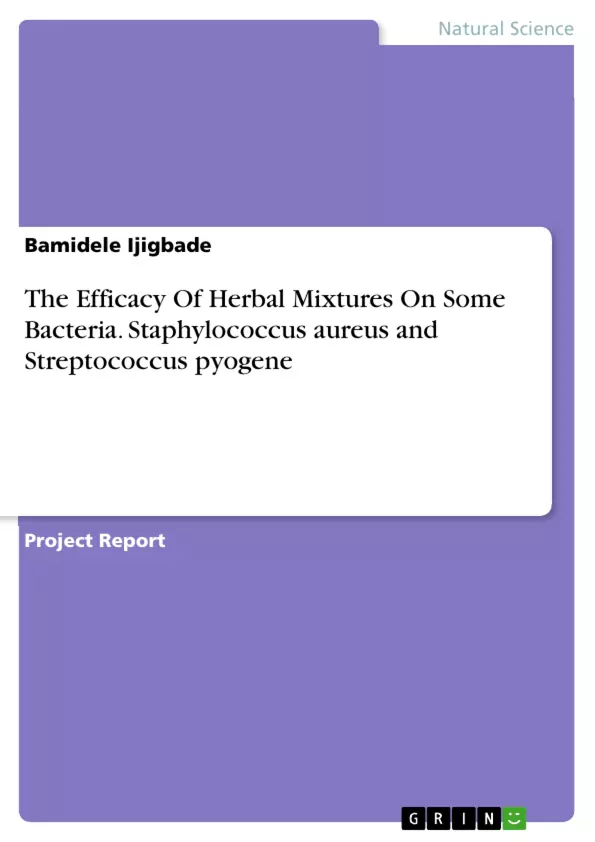This study is on the efficacy of herbal mixtures on some selected bacteria, Staphylococcus aureus and Streptococcus pyogene was conducted. The zone diameter of inhibition in millimeter of Aqueous extracts of herbal mixture at concentration of 500 mg/ml against Staphylococcus aureus shows that Herbal mixture met the standard of the antibiotic used as the positive control (Chloramphenicol) with 25.0±1.0 mm each.
Meanwhile Streptococcus pyogene had significant zone diameter of inhibition (24mm against the herbal mixtures) at concentration of 500mg/ml. The extracts of the herbal mixture had the minimum inhibition concentration (MIC) of 200 mg/ml against Staphylococcus aureus and which correlate with the control (Chloramphenicol), while the MIC of 400 mg/ml against Streptococcus pyogene respectively.
The Minimum bactericidal concentration of the extracts shows that the herbal mixtures have the least value of 400 mg/ml which correlates with the standard antibiotic (Chloramphenicol) used as control against Streptococcus pyogene. The Herbal mixture had MBC of 400 mg/ml which also correlates with the standard antibiotics drug (Chloramphenicol).
Inhaltsverzeichnis (Table of Contents)
- CHAPTER ONE: Introduction
- CHAPTER TWO: Literature review
- CHAPTER THREE: Material and Method
- CHAPTER FOUR: Results
- CHAPTER FIVE: Discussions and Conclusions
Zielsetzung und Themenschwerpunkte (Objectives and Key Themes)
This study aims to determine the efficacy of herbal mixtures against selected bacteria, Staphylococcus aureus and Streptococcus pyogenes. It investigates the antibacterial properties of these mixtures, specifically focusing on their minimum inhibitory and bactericidal concentrations.
- Antibacterial efficacy of herbal mixtures.
- Minimum inhibitory concentration (MIC) of herbal mixtures.
- Minimum bactericidal concentration (MBC) of herbal mixtures.
- The role of herbal medicine in addressing antibiotic resistance.
- Microbial contamination in herbal medicinal products (HMPs).
Zusammenfassung der Kapitel (Chapter Summaries)
CHAPTER ONE: Introduction: This chapter sets the stage for the study by highlighting the widespread use of herbal medicines, particularly in developing countries, and the growing concern regarding antibiotic resistance. It emphasizes the need to assess the safety and efficacy of herbal preparations and to monitor their microbial purity to prevent the emergence of drug-resistant strains. The chapter clearly states the aim and objectives of the study, focusing on evaluating the antibacterial efficacy of specific herbal mixtures against Staphylococcus aureus and Streptococcus pyogenes, along with determining their MIC and MBC values. The introduction successfully establishes the context, rationale, and scope of the research.
CHAPTER TWO: Literature review: This chapter provides a comprehensive overview of the existing literature on medicinal plants in Nigeria and their antimicrobial activities. It discusses the global challenge of infectious diseases and the increasing prevalence of antibiotic-resistant bacteria. The review highlights the importance of exploring plant-based remedies as potential sources of new therapeutic agents. Specific examples of plant-based treatments for diseases like tuberculosis and the problem of antimicrobial resistance are discussed, emphasizing the need for ongoing research into safe and effective alternatives.
Schlüsselwörter (Keywords)
Herbal medicine, antibiotic resistance, Staphylococcus aureus, Streptococcus pyogenes, minimum inhibitory concentration (MIC), minimum bactericidal concentration (MBC), antibacterial efficacy, microbial contamination, Nigeria.
Frequently Asked Questions: Comprehensive Language Preview of Antibacterial Efficacy of Herbal Mixtures
What is the main focus of this study?
This study investigates the antibacterial efficacy of herbal mixtures against Staphylococcus aureus and Streptococcus pyogenes. It specifically aims to determine the minimum inhibitory concentration (MIC) and minimum bactericidal concentration (MBC) of these mixtures.
What are the key objectives of the research?
The key objectives include evaluating the antibacterial properties of the herbal mixtures, determining their MIC and MBC values, exploring the role of herbal medicine in addressing antibiotic resistance, and investigating potential microbial contamination in herbal medicinal products (HMPs).
What is covered in the literature review?
The literature review comprehensively examines existing research on medicinal plants in Nigeria and their antimicrobial activities. It addresses the global challenge of infectious diseases and the rise of antibiotic-resistant bacteria, highlighting the potential of plant-based remedies as alternative therapeutic agents.
What are the key themes explored in the study?
Key themes include the antibacterial efficacy of herbal mixtures, MIC and MBC determination, the role of herbal medicine in combating antibiotic resistance, and the issue of microbial contamination in HMPs.
What specific bacteria are targeted in this study?
The study focuses on two specific bacteria: Staphylococcus aureus and Streptococcus pyogenes.
What are the chapter summaries included in the preview?
The preview includes summaries of each chapter: Chapter One (Introduction), Chapter Two (Literature Review), Chapter Three (Material and Method - not detailed in the preview), Chapter Four (Results - not detailed in the preview), and Chapter Five (Discussions and Conclusions - not detailed in the preview).
What are the key words associated with this study?
Key words include herbal medicine, antibiotic resistance, Staphylococcus aureus, Streptococcus pyogenes, minimum inhibitory concentration (MIC), minimum bactericidal concentration (MBC), antibacterial efficacy, microbial contamination, and Nigeria.
What is the overall goal of this research?
The overall goal is to contribute to the understanding of the antibacterial potential of herbal mixtures as a possible alternative or complementary approach to combatting antibiotic-resistant bacteria.
- Citar trabajo
- Bamidele Ijigbade (Autor), 2023, The Efficacy Of Herbal Mixtures On Some Bacteria. Staphylococcus aureus and Streptococcus pyogene, Múnich, GRIN Verlag, https://www.grin.com/document/1320365



